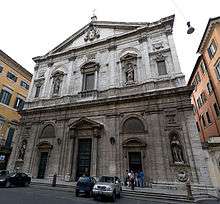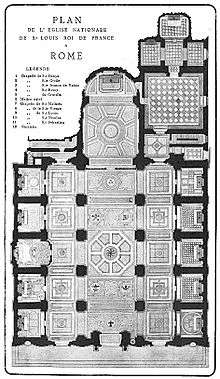San Luigi dei Francesi
| Church of St. Louis of the French San Luigi dei Francesi (Italian) Saint Louis des Français (French) S. Ludovici Francorum de Urbe (Latin) | |
|---|---|
 Façade of San Luigi dei Francesi, National Church in Rome of France. | |
| Basic information | |
| Location |
|
| Geographic coordinates | 41°53′58.5″N 12°28′28.8″E / 41.899583°N 12.474667°ECoordinates: 41°53′58.5″N 12°28′28.8″E / 41.899583°N 12.474667°E |
| Affiliation | Roman Catholic |
| Ecclesiastical or organizational status | Titular church, National Church in Rome of France |
| Leadership | Mgr Patrick Valdrini[1] |
| Website |
www |
| Architectural description | |
| Architect(s) | Giacomo della Porta, Domenico Fontana |
| Architectural type | Church |
| Architectural style | Baroque |
| Completed | 1589 |
| Specifications | |
| Direction of façade | E |
| Length | 51 metres (167 ft) |
| Width | 35 metres (115 ft) |
| Width (nave) | 14 metres (46 ft) |
The Church of St. Louis of the French (Italian: San Luigi dei Francesi, French: Saint Louis des Français, Latin: S. Ludovici Francorum de Urbe) is a Roman Catholic church in Rome, not far from Piazza Navona. The church is dedicated to the Virgin Mary, to St. Denis the Areopagite and St. Louis IX, king of France. The church was designed by Giacomo della Porta and built by Domenico Fontana between 1518 and 1589, and completed through the personal intervention of Catherine de' Medici, who donated to it some property in the area. It is the national church in Rome of France.[2][3] It is a titular church. The current Cardinal-Priest of the Titulus S. Ludovici Francorum de Urbe is André Vingt-Trois, Archbishop of Paris.
History
When the Saracens burned the Abbey of Farfa in 898, a group of refugees settled in Rome.[4] Some monks remained in Rome even after their abbot Ratfredus (934-936) rebuilt the abbey. By the end of the tenth century, the Abbey of Farfa owned in Rome churches, houses, windmills and vineyards. A bull of Holy Roman Emperor Otto III in 998 confirms the property of three churches:[5] Santa Maria, San Benedetto and the oratorio of San Salvatore. When they ceded their property to the Medici family in 1480, the church of Santa Maria became the church of Saint Louis of the French. Cardinal Giulio di Giuliano de' Medici commissioned Jean de Chenevière to build a church for the French community in 1518.[6] Chenevières' design was for an octagonal, centrally planned edifice.[7] Building was halted when Rome was sacked in 1527, and the church was finally completed in 1589 by Domenico Fontana and Giacomo della Porta, who designed the façade, according to an entirely different design. The church was consecrated by the Cardinal François de Joyeuse, Protector of France before the Holy See, on 8 October 1589.[8] The interior was restored by Antoine Dérizet between 1749 and 1756.
The foundation Pieux Etablissements de la France à Rome et à Lorette is responsible for the five French churches in Rome and apartment buildings in Rome and in Loreto. The foundation is governed by an "administrative deputy" named by the French Ambassador to the Holy See.
Exterior
Giacomo della Porta made the façade as a piece of decorative work entirely independent of the body of the structure, a method much copied later.[9] The French character is evident from the façade itself, which has several statues recalling national history: these include Charlemagne, St. Louis, St. Clothilde and St. Jeanne of Valois. The interior also has frescoes by Charles-Joseph Natoire recounting stories of Saint Louis IX, Saint Denis and Clovis.
_-_Ceiling_HDR.jpg)
Interior
Domenichino painted here one of his masterworks, the frescoes portraying the Histories of Saint Cecilia. Other artists who worked in the decoration of San Luigi dei Francesi include Cavalier D'Arpino, Francesco Bassano il Giovane, Muziano, Giovanni Baglione, Siciolante da Sermoneta, Jacopino del Conte, Tibaldi and Antoine Derizet.
The church's most famous treasure is, however, the cycle of paintings in the Contarelli Chapel, painted by the Baroque master Caravaggio in 1599-1600 about the life of St. Matthew. This include the three world-renowned canvases of The Calling of St Matthew (on the left wall), The Inspiration of Saint Matthew (above the altar), The Martyrdom of Saint Matthew (on the right wall).

 The Inspiration of St. Matthew
The Inspiration of St. Matthew The Martyrdom of St. Matthew
The Martyrdom of St. Matthew Interior
Interior Merklin organ
Merklin organ

Burials
The church was chosen as the burial place for a number of higher prelates and members of the French community of Rome:[10] these include the classic liberal economist Frédéric Bastiat, Cardinal François-Joachim de Pierre de Bernis, ambassador in Rome for Louis XV and Louis XVI,[11] and Henri Cleutin the French Lieutenant in 16th-century Scotland. There is also the tomb of Pauline de Beaumont, who died of consumption in Rome in 1805, erected by her lover Chateaubriand.
The inscriptions found in San Luigi dei Francesi, a valuable source illustrating the history of the church, have been collected and published by Vincenzo Forcella.[12]
Ospizio San Luigi dei Francesi
Adjacent to the church is the late-Baroque Ospizio San Luigi dei Francesi. It was built in 1709-1716 as a place to stay for the French religious community and pilgrims without resources.[13] Its porch has a bust of Christ whose face is traditionally identified as Cesare Borgia's. The interior houses a gallery with portraits of the French kings and a notable Music Hall.
Cardinal-Priests of S. Luigi dei Francesi
The Church of S. Louis was designated as a cardinalatial titulus on 7 June 1967, by Pope Paul VI.[14]
- Pierre Veuillot (29 June 1967 – 14 February 1968)
- François Marty (30 April 1969 – 16 February 1994)
- Jean-Marie Lustiger (26 November 1994 – 5 August 2007)
- André Armand Vingt-Trois (24 November 2007 – Present)
Notes
- ↑ Ambassade de France près le Saint-Siège, Saint-Louis des Français "Archived copy". Archived from the original on 2008-05-30. Retrieved 2009-08-30..
- ↑ Les pieux établissements de la France à Rome et à Lorette (in French)
- ↑ Les églises françaises à Rome (Official website)
- ↑
 Goyau, Georges (1913). "Abbey of Farfa". In Herbermann, Charles. Catholic Encyclopedia. New York: Robert Appleton Company.
Goyau, Georges (1913). "Abbey of Farfa". In Herbermann, Charles. Catholic Encyclopedia. New York: Robert Appleton Company. - ↑ Stroll, Mary (1997), The medieval Abbey of Farfa: target of papal and imperial ambitions, Volume 74 of Brill's studies in intellectual history, pp. 32–33, ISBN 978-90-04-10704-5
- ↑ Lesellier, J. (1931), Jean de Chenevières, sculpteur et architecte de l'église Saint-Louis-des-Français à Rome, Mélanges d'archéologie et d'histoire, 48 (48), pp. 233-267.
- ↑ Stefan Grundmann, Ulrich Fürst, The Architecture of Rome: An Architectural History in 400 Individual Presentations (Stuttgart: Edition Axel Menges, 1998), p. 180.
- ↑ Armailhacq, p. 183.
- ↑
 Gietmann, G. (1913). "Giacomo della Porta". In Herbermann, Charles. Catholic Encyclopedia. New York: Robert Appleton Company.
Gietmann, G. (1913). "Giacomo della Porta". In Herbermann, Charles. Catholic Encyclopedia. New York: Robert Appleton Company. - ↑ Arnaud (1892), pp. 59-61, listed twenty-seven burials.
- ↑ He died in 1794. Only his heart is buried at S. Luigi. His remains were transferred to France: Armailhacq, p. 216.
- ↑ V. Forcella, Inscrizioni delle chese e d' altre edifici di Roma, dal secolo XI fino al secolo XVI Volume III (Roma: Fratelli Bencini, 1873), pp. 1-103.
- ↑ Arnaud, pp. 44-48, gives the early history of the Hospice, which began through the action of Jacques Bugnet, Archdeacon of Chartres and Doctor in utroque iure, in 1480.
- ↑ David M. Cheney, Catholic-Hierarchy:San Luigi dei Francesi. Accessed: 03/11/2016.
Sources
- Patrizia Tosini, Natalia Gozzano (editors), La Cappella Contarelli in San Luigi dei Francesi (Roma: Gangemi Editore, 2012).
- Calogero Bellanca, Oliva Muratore, O. Muratore, Una didattica per il restauro II: esperienze a San Luigi dei Francesi e San Nicola dei Lorenesi (Firenze: Alinea, 2009).
- Sebastiano Roberto, San Luigi dei Francesi: la fabbrica di una chiesa nazionale nella Roma del '500 (Roma: Gangemi, 2005).
- Claudio Rendina, Enciclopedia di Roma. Newton Compton, Rome, 1999.
- Francesco Quinterio, Franco Borsi, Luciano Tubello, Il palazzo dei senatori a San Luigi de' Francesi (Roma: Editalia, 1990).
- Albert Armailhacq, L' église nationale de Saint Louis des Français a Rome: notes historiques et descriptives (Rome: Philip Cuggiani 1894).
- Jean Arnaud, Mémoire historique sur les Institutions de la France à Rome, 2nd edition (Rome: Editrice Romana 1892).
External links
| Wikimedia Commons has media related to San Luigi dei Francesi. |
- Official website of the Diocese of Rome, Chiesa Rettoria San Luigi dei Francesi in Campo Marzio
- Official website of the Church